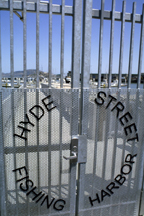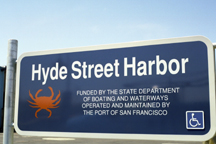 |
| New single
entrance gate greatly improves security for fishermen |
What’s been uppermost in our
minds as we saw this project through is that the traditional center
of the fishing fleet has always been at Fishermen’s Wharf, Meigg’s
Wharf originally. Although Fishermen’s Wharf certainly is a
tourist attraction, all you have to do is go down beyond Jefferson
Street to come upon a very vital fish handling and processing
operation. There are over a dozen fish handling and processing
operators down at Pier 45.
Altogether the fishing industry
is a $100 million-plus annual business for San Francisco. It
sometimes surprises people to learn that a great deal of the fish
handled in the fish processing area of Fishermen’s Wharf comes in
not by sea but over the road or by air. In order to supply fish day
in and day out to restaurants, particularly a lot of the more exotic
fish that are sold, they have to go to sources all around the world.
I would say over 80% of it comes
in that way.
Fishing is a pretty tightly
regulated industry and there’s always Mother Nature. For instance,
it’s salmon season but there’s been gale force winds out there
for two weeks almost so they haven’t been able to get out there
and fish. But the restaurants want their salmon so they’re getting
them right now from up north, into Alaska, off the coast of Chile
and Scotland. Likewise, some of the other fish…Orange Roughy, for
example, is a really hot fish. That comes out of the Tasmanian Sea,
between the island of Tasmania and Australia. During the salmon
season, the King Salmon that they catch here is very highly prized
by gourmets. Restaurants in the know are going to do their best to
provide fresh locally caught salmon. It’s the tastiest, the
freshest because wild salmon is a lot more tastier and beautiful on
the plate than a foreign salmon or a salmon that’s been sitting on
ice for a while.
 |
| The new Hyde
Street Fishing Harbor: all dressed up and ready to go. |
Environmental concerns sincerely
have been concern number one as we’ve developed this project.
Industrial and commercial activities in the urban setting are
increasingly scrutinized, so we’re held to a higher standard then
other fishing centers like Half Moon Bay and Bodgea Bay. But we’re
happy to meet the challenge because it’s the right thing to do.
This new Harbor proves you can run a commercial fishing operation in
the middle of an urban setting and still respect the environment.